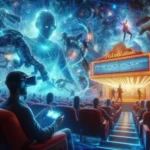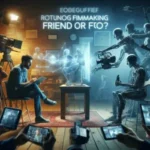As the silver screen continues to evolve, the future of film is poised to be more exciting and transformative than ever before.
With rapid advancements in technology, shifting audience preferences, and a growing emphasis on inclusivity and diversity, the cinematic landscape is undergoing a profound metamorphosis. From the rise of streaming platforms revolutionizing distribution methods to the integration of virtual reality and interactive storytelling, filmmakers are breaking traditional boundaries and reimagining how stories are told and experienced. In this blog post, we will explore the key trends and innovations that are set to shape the future of cinema, examining how these developments are not only enhancing the filmmaking process but also redefining audience engagement in ways we could only dream of just a few years ago. Join us on this journey into the future of film, where creativity knows no limits and the magic of storytelling continues to thrive.
1. Introduction: The Evolution of Film
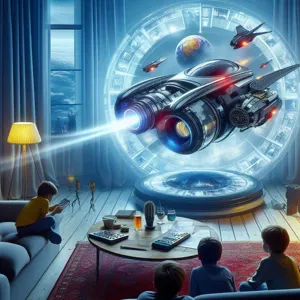
The world of cinema has undergone a remarkable transformation since its inception over a century ago. From the flickering black-and-white frames of silent films to the dazzling, high-definition visuals of today, the evolution of film is a testament to the relentless pursuit of innovation in storytelling, technology, and audience engagement. Each era has introduced groundbreaking techniques and ideas that have redefined the cinematic experience and expanded the possibilities of what film can achieve.
In the early 1900s, film was a novel art form, captivating audiences with its ability to transport them into different worlds. As sound was introduced in the late 1920s, films became richer and more immersive, allowing for dialogue and music to enhance storytelling. The mid-20th century saw the rise of color film, which added a new layer of vibrancy and depth, inviting viewers to experience stories in a way that mirrored the richness of real life.
Today, we find ourselves on the cusp of another significant transformation. The advent of digital technology has revolutionized film production and distribution, making it more accessible to filmmakers and audiences alike. Streaming platforms have shifted the way we consume content, providing a diverse range of films at our fingertips and altering traditional viewing habits. Meanwhile, advancements in virtual reality (VR) and augmented reality (AR) are pushing the boundaries of storytelling, offering immersive experiences that blur the lines between the audience and the narrative.
As we look to the future, the evolution of film will continue to be driven by these advancements and the ever-changing tastes of audiences. In this blog post, we will explore the emerging trends and innovations that are shaping the future of cinema, from the rise of interactive storytelling to the integration of artificial intelligence in filmmaking. Join us as we delve into the fascinating journey of film and discover what lies ahead in this dynamic medium.
2. The Rise of Streaming Services and Its Impact on Traditional Cinema
The landscape of cinema is undergoing a seismic shift, primarily driven by the meteoric rise of streaming services. As platforms like Netflix, Amazon Prime Video, Disney+, and countless others gain traction, traditional cinema is feeling the pressure to adapt or risk obsolescence. This transition is not merely a change in how audiences consume films but a complete redefinition of the cinematic experience itself.
Gone are the days when viewers had to plan outings to theaters, navigating schedules and ticket lines. With a vast library of films available at the touch of a button, streaming has made it possible for audience members to enjoy their favorite movies from the comfort of their homes, on their own terms. This convenience is particularly appealing in today’s fast-paced world, where time is of the essence. As a result, fewer people are flocking to theaters, leading to a decline in box office revenues for many traditional studios.
However, this trend is not without its silver linings. The rise of streaming services has democratized film distribution, allowing independent filmmakers to reach global audiences without the need for traditional studio backing. These platforms often prioritize diversity and innovation, showcasing unique stories that might have otherwise remained in obscurity. This shift has opened doors for a new wave of talent, making room for fresh voices and perspectives that enrich the cinematic landscape.
Moreover, the competition has spurred traditional cinemas to rethink their strategies. Many theaters are now enhancing the customer experience by offering luxury seating, gourmet concessions, and immersive technologies like IMAX and 4DX to draw audiences back. Some have even begun to diversify their offerings by hosting live events, screenings of classic films, or exclusive premieres that cannot be found on streaming platforms.
As this dynamic evolves, the future of film will likely be a hybrid model, where streaming and traditional cinema coexist. Filmmakers may increasingly design projects with both mediums in mind, crafting narratives that can be enjoyed in a theater and tailored for home viewing. The challenge for traditional cinemas will be to create an experience that streaming cannot replicate—one that fosters a sense of community and shared experience among moviegoers.
In conclusion, the rise of streaming services is reshaping the film industry in profound ways, challenging traditional cinema to innovate and adapt. While the future may present hurdles, it also offers unprecedented opportunities for storytelling and audience engagement, making it an exciting time for cinema as a whole.
3. Virtual Reality (VR) and Augmented Reality (AR) in Filmmaking
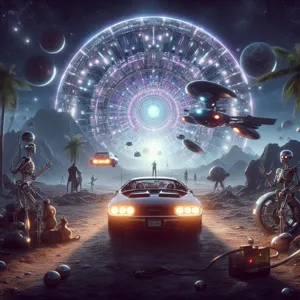
As the boundaries of storytelling continue to expand, Virtual Reality (VR) and Augmented Reality (AR) are at the forefront of a cinematic revolution. These immersive technologies are not just gimmicks; they represent a profound shift in how audiences experience narratives. In traditional filmmaking, viewers are simple observers, passively absorbing the story from a fixed perspective. However, with VR and AR, audiences are invited to step inside the narrative, becoming active participants in the unfolding drama.
Imagine donning a VR headset and finding yourself on the bustling streets of a futuristic city, where you can explore the environment, interact with characters, and make choices that influence the storyline. This level of immersion transforms the act of watching a film into an experiential journey, blurring the lines between entertainment and interactivity. Filmmakers are now experimenting with these technologies to create multi-layered narratives that challenge conventional storytelling techniques.
AR, on the other hand, enhances the real world by overlaying digital elements onto our physical environment. Picture a scene where a character interacts with an augmented version of a beloved film icon, providing viewers with a unique layer of engagement that extends beyond the screen. This technology can transform marketing for films, allowing fans to interact with their favorite characters or settings through their smartphones, creating buzz and deepening their connection to the film.
As these technologies evolve, so too will the tools available to filmmakers. Innovations in camera technology, software for editing, and platforms for distribution will enable creators to craft increasingly sophisticated VR and AR experiences. The future of film is not just about what we see on screen but how we feel and connect with the stories being told. Embracing VR and AR is not merely an option for filmmakers; it is becoming essential in captivating audiences and pushing the boundaries of what cinema can achieve. The next wave of storytelling is here, and it invites us all to step beyond the frame.
4. The Role of Artificial Intelligence in Storytelling and Production
As we stand on the brink of a new era in filmmaking, the role of artificial intelligence (AI) is becoming increasingly prominent, reshaping how stories are told and produced. AI technologies are no longer confined to the realm of science fiction; they are now integral tools that can enhance creativity, streamline processes, and even generate content.
One of the most fascinating applications of AI in storytelling lies in scriptwriting. Advanced algorithms can analyze vast amounts of data from successful films and screenplays, identifying patterns and themes that resonate with audiences. This data-driven approach allows writers to experiment with new ideas while ensuring that the narrative maintains a commercial appeal. AI can assist in drafting outlines, generating dialogue, or suggesting plot twists, providing a collaborative partner for screenwriters navigating the complex landscape of modern cinema.
In production, AI is revolutionizing the way films are made. From pre-visualization to editing, AI-powered tools can optimize workflows, saving time and resources. For instance, AI can assist in casting by analyzing actors’ past performances and audience reactions, helping directors make informed choices. During the editing process, machine learning algorithms can sift through hours of footage, identifying the best takes and even suggesting cuts that enhance pacing and emotional impact. This technology not only increases efficiency but also allows filmmakers to focus more on the creative aspects of their work.
Moreover, AI is stepping into the realm of visual effects and animation. By using deep learning techniques, filmmakers can create lifelike characters and environments that were once the exclusive domain of large studios with hefty budgets. AI can help streamline complex processes like motion capture and CGI, making high-quality production more accessible to independent filmmakers and smaller studios.
As these innovations continue to unfold, the potential for AI in the film industry appears limitless. While some may fear that AI could overshadow human creativity, the reality is that it serves as a powerful ally. By augmenting the creative process, AI empowers filmmakers to push boundaries, explore new storytelling techniques, and ultimately, craft more engaging and immersive cinematic experiences. As we look to the future, it’s clear that the integration of artificial intelligence into film production will not only shape how stories are told but also redefine the very essence of cinema itself.
5. Advances in Filmmaking Technology: Cameras, Editing, and Visual Effects
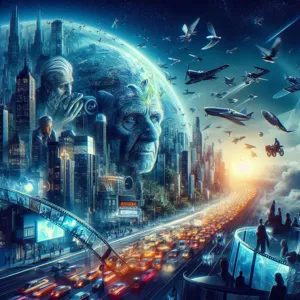
The landscape of filmmaking is undergoing a remarkable transformation, propelled by rapid advancements in technology that are reshaping how stories are told on screen. At the forefront of this evolution are the innovations in cameras, editing software, and visual effects, which together create a canvas for filmmakers to push the boundaries of their creativity.
Modern cameras have evolved dramatically, with digital technology allowing for unprecedented image quality and versatility. High-resolution sensors now capture stunning detail, even in low-light conditions, while compact mirrorless cameras are giving indie filmmakers the ability to shoot high-quality film on smaller budgets. The introduction of 8K resolution cameras is also setting a new standard for visual fidelity, allowing filmmakers to capture intricate details that can be used in various formats, from big screens to mobile devices.
Editing technology has similarly advanced, with software becoming more intuitive and accessible. Programs like Adobe Premiere Pro and DaVinci Resolve offer powerful tools that enable editors to manipulate footage with precision and ease. The rise of AI in editing processes has streamlined workflows, allowing for automated editing suggestions and faster post-production times. This has not only made the editing process more efficient but has also opened the door for new storytelling techniques, as filmmakers can experiment with pacing and structure like never before.
Visual effects (VFX) have also reached new heights, blending seamlessly with live-action footage to create breathtaking scenes that were once thought to be the realm of science fiction. Technologies such as virtual reality (VR) and augmented reality (AR) are not just gimmicks but are becoming integral to storytelling, allowing audiences to immerse themselves in narratives in ways previously unimaginable. The groundbreaking work of companies specializing in digital effects, such as ILM and Weta Digital, is setting a precedent for how films are visualized and experienced.
As these technologies continue to evolve, they will undoubtedly influence the narratives we see on screen. Filmmakers are increasingly able to experiment with innovative techniques that enhance storytelling, allowing for more visually captivating and emotionally resonant experiences. The future of film is bright, driven by the relentless pursuit of innovation in filmmaking technology, and audiences should prepare for a cinematic experience that is more immersive, engaging, and transformative than ever before.
6. Interactive Storytelling: Changing Audience Engagement
Interactive storytelling is revolutionizing the way audiences engage with films, offering a dynamic departure from traditional passive viewing. This innovative approach puts the power in the hands of the viewer, allowing them to influence the direction of the narrative, make choices for the characters, and even alter the ending of the story. As technology continues to evolve, filmmakers are leveraging interactive platforms to create immersive experiences that captivate and enthrall audiences.
Imagine watching a film where, at key moments, you’re prompted to make a choice—should the hero confront the villain or seek an ally? This level of engagement invites viewers to become active participants rather than mere spectators, fostering a deeper emotional connection to the characters and the storyline. Platforms like Netflix have already begun experimenting with this format, releasing projects such as “Black Mirror: Bandersnatch,” which allows viewers to dictate the course of the plot through a series of choices.
The implications of interactive storytelling extend beyond just entertainment; they challenge the very essence of narrative structure and character development. Filmmakers must now consider multiple pathways and endings, crafting stories that are not only compelling but also flexible. This opens up new avenues for creativity, as writers and directors explore how to maintain coherence and depth within a non-linear framework.
Furthermore, interactive storytelling can enhance communal viewing experiences. Imagine hosting a movie night where friends collectively make decisions about the film’s direction, leading to spontaneous discussions and varying outcomes. This shared experience can transform how we perceive and discuss cinema, creating a vibrant culture of engagement around films.
As we look toward the future, it’s clear that interactive storytelling will play a pivotal role in shaping audience engagement. By blurring the lines between viewer and participant, filmmakers are not only reimagining how stories are told but also cultivating a more invested and connected audience. This trend is set to redefine the cinematic landscape, paving the way for a new era where every viewer’s experience is uniquely their own.
7. Diversity and Representation in Modern Cinema
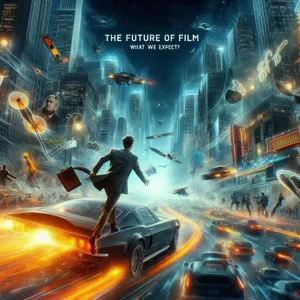
In recent years, the demand for diversity and representation in modern cinema has surged, reflecting a broader societal push for inclusivity across all sectors. Audiences are increasingly craving stories that resonate with their own experiences, and filmmakers are rising to the challenge by embracing a wider array of voices and perspectives. This shift is not just a trend; it signifies a fundamental change in how films are produced and marketed.
The impact of this movement is evident in the types of stories being told and the talent being highlighted on screen. From major blockbusters to independent films, we are witnessing a growing array of characters from diverse backgrounds—be it race, gender, sexuality, or ability. This representation not only enriches the storytelling experience but also fosters a deeper connection between the audience and the narrative. For example, films like “Black Panther” and “Crazy Rich Asians” have not only achieved commercial success, but they have also sparked conversations about cultural representation in Hollywood, proving that diverse narratives can resonate with global audiences.
Moreover, the push for diversity isn’t limited to casting choices; it extends behind the camera as well. More directors, writers, and producers from underrepresented communities are taking the helm, bringing fresh perspectives and innovative storytelling techniques that challenge conventional norms. This change is being fueled by initiatives aimed at supporting diverse filmmakers, such as funding programs and mentorship opportunities that seek to amplify minority voices in the industry.
As we look to the future of film, the importance of diversity and representation will only grow. Audiences are becoming more discerning, and they want to see stories that reflect the rich tapestry of human experience. This demand will likely influence everything from the types of films produced to the way they are marketed, driving the industry toward a more inclusive and representative future. Embracing this diversity not only makes for richer storytelling but also ensures that cinema remains a vibrant and relevant medium that speaks to the hearts and minds of all viewers.
8. Environmental Sustainability in Film Production
As the world grapples with the pressing challenges of climate change, the film industry is stepping up to embrace environmental sustainability in production practices. The future of cinema will increasingly be defined by the commitment to reducing carbon footprints, conserving resources, and promoting eco-friendly methodologies.
Production companies are now prioritizing the use of renewable energy sources, such as solar and wind power, to fuel their sets and equipment. This shift not only minimizes the reliance on fossil fuels but also sets a powerful example for audiences and other industries. From shooting on location to incorporating sustainable materials in set design, filmmakers are finding innovative ways to align their creative processes with environmental stewardship.
Moreover, there is a growing emphasis on sustainable transportation methods for cast and crew, with electric vehicles becoming more common on set. Production teams are also adopting digital technologies to streamline workflows, reducing the need for physical resources such as paper scripts and printed promotional materials.
In addition to operational changes, filmmakers are increasingly weaving environmental themes into their narratives, raising awareness about ecological issues through storytelling. Documentaries and feature films focusing on climate change, conservation, and sustainability are gaining traction, encouraging viewers to reflect on their own impact on the planet.
As audiences become more conscious of their environmental footprint, they are looking for films that not only entertain but also resonate with their values. This demand is pushing studios to adopt more sustainable practices, ensuring that the films of tomorrow are as green as they are groundbreaking.
Overall, environmental sustainability is set to redefine the way films are produced, marketed, and consumed, creating a more responsible and conscientious future for cinema that aligns with the values of a new generation of viewers.
9. The Influence of Social Media on Film Marketing and Distribution
In an age where social media dominates our daily lives, its influence on film marketing and distribution has become undeniable. Gone are the days when traditional advertising, such as billboards and television spots, reigned supreme. Instead, filmmakers and studios are now harnessing the power of platforms like Instagram, TikTok, Twitter, and Facebook to create buzz and engage audiences like never before.
Social media is not just a tool for promotion; it’s a dynamic ecosystem where films can find their audience and generate excitement long before a release date. Viral marketing campaigns, engaging trailers, and behind-the-scenes content are quickly becoming standard practices. For example, the success of films like “The Blair Witch Project” and “Paranormal Activity” can be attributed in part to their innovative use of social media to create a grassroots campaign that sparked curiosity and conversation.
Platforms like TikTok are particularly influential among younger audiences, who are drawn to short, engaging video content. Filmmakers are now crafting snippets, challenges, and memes that encourage user participation, allowing fans to become ambassadors for the film. This organic engagement not only drives interest but also creates a sense of community around the film, making audiences feel invested long before they hit the theaters.
Moreover, social media’s role in distribution cannot be overlooked. Streaming platforms often leverage social media trends to gauge audience interest and tailor their release strategies accordingly. As films gain traction online, studios can make data-driven decisions about where and how to release their content, maximizing reach and impact.
In this evolving landscape, filmmakers must adapt their marketing strategies to leverage the power of social media effectively. By building relationships with audiences, creating shareable content, and tapping into the latest trends, they can ensure that their films not only get seen but resonate deeply with viewers. As technology continues to evolve, the symbiotic relationship between film and social media will undoubtedly shape the future of cinema, making it more interconnected and audience-driven than ever before.
10. The Future of Film Festivals in a Digital Age
As the landscape of cinema continues to evolve, so too do the film festivals that showcase this art form. In a digital age characterized by rapid technological advancements and shifting audience expectations, the future of film festivals is poised for transformation. No longer confined to traditional venues, festivals are embracing innovative formats that cater to a more diverse and global audience.
Virtual and hybrid festivals are becoming increasingly popular, allowing filmmakers to reach audiences far beyond geographical limitations. With the rise of streaming technology, viewers can now experience the excitement of a film festival from the comfort of their own homes. This shift not only broadens accessibility but also democratizes the festival experience, enabling independent filmmakers to showcase their work to a wider audience without the barriers of travel and logistics.
Moreover, digital platforms are fostering new ways for audiences to engage with films. Q&A sessions with filmmakers can now be held live online, allowing for real-time interaction and discussion, which enhances the viewing experience. Social media campaigns and online communities are also vital for building anticipation and connection among audiences, creating a sense of belonging that extends beyond the festival dates.
As festivals adapt to these digital innovations, they also face the challenge of preserving the communal spirit that makes them so special. The magic of watching a film in a crowded theater, sharing laughter and tears with strangers, and participating in vibrant discussions after a screening is irreplaceable. Therefore, many festivals are seeking to find a balance, offering both in-person events and digital access, ensuring that they cater to every preference.
In this new era, film festivals are not just venues for screenings; they are becoming hubs for networking, education, and cultural exchange. With masterclasses, workshops, and panel discussions being integrated into virtual programming, attendees can gain valuable insights from industry leaders and peers alike. This holistic approach enriches the festival experience, making it a platform for learning and connection.
In conclusion, the future of film festivals in a digital age is bright and multifaceted. As they embrace innovation while honoring tradition, these festivals will continue to evolve, adapting to the needs of filmmakers and audiences alike. With creativity at the forefront, the cinematic experience will be more immersive, accessible, and engaging than ever before. Whether online or in person, film festivals will remain a vital part of the cinematic landscape, celebrating the art of storytelling in all its forms.
11. Globalization of Cinema: Cross-Cultural Collaborations and Influences
The globalization of cinema is transforming the filmmaking landscape, leading to a rich tapestry of cross-cultural collaborations and influences that redefine storytelling. As technology continues to dissolve geographical barriers, filmmakers are increasingly collaborating across borders, melding diverse perspectives and cultural narratives into their projects. This trend not only broadens the appeal of films but also fosters a deeper understanding of different cultures among audiences worldwide.
In recent years, we’ve witnessed groundbreaking partnerships between filmmakers from various countries, resulting in films that resonate on multiple levels. For instance, the acclaimed film “Parasite,” directed by South Korean Bong Joon-ho, not only captivated audiences with its unique storytelling but also sparked conversations about class disparity that transcended its national boundaries. Similarly, Hollywood’s increasing interest in Asian cinema, as seen in the success of franchises like “Crazy Rich Asians,” highlights the demand for diverse narratives that reflect our interconnected world.
Moreover, platforms like Netflix and Amazon Prime Video are championing this globalization, providing a stage for international films and series that might have previously gone unnoticed. By investing in local productions and promoting them to a global audience, these platforms are not just expanding their content libraries; they are enriching the cinematic experience for viewers, who are now exposed to a plethora of narratives from different cultures.
As we move forward, the fusion of cultural elements in filmmaking will likely become more pronounced. Expect to see stories that blend genres, traditions, and aesthetics, resulting in innovative cinematic experiences that challenge conventional storytelling. This trend not only enriches the film industry but also encourages a more inclusive approach to filmmaking, allowing voices from all corners of the globe to be heard and celebrated. In this era of globalization, cinema is not merely a reflection of one culture but a vibrant dialogue among many, paving the way for a future where diversity is not just welcomed but essential to the art of storytelling.
12. The Shift Towards Shorter Formats: Web Series and Mini-Series
In recent years, the film industry has experienced a significant shift, with audiences increasingly gravitating towards shorter formats such as web series and mini-series. This trend is reshaping the way stories are told and consumed, driven by the fast-paced lifestyles of modern viewers who often prefer bite-sized content over lengthy feature films.
The rise of streaming platforms like Netflix, Hulu, and Amazon Prime Video has played a pivotal role in this transition. These platforms not only provide a vast array of content but also cater to the growing demand for flexibility in viewing habits. Viewers can now binge-watch an entire season of a web series in one sitting or savor a mini-series over a few evenings, allowing for a more personalized viewing experience. This accessibility has led to an explosion of creative storytelling, where filmmakers can explore narratives in a more concise format, focusing on character development and plot progression without the constraints of traditional runtime.
Additionally, the shorter format allows for greater experimentation. Filmmakers are now free to explore unique genres and unconventional storytelling techniques, resulting in a diverse range of content that appeals to various demographics. From gripping thrillers to heartfelt comedies, the web series format provides a platform for both established filmmakers and emerging voices to showcase their talent.
Moreover, the shift towards shorter formats aligns with the preferences of younger audiences, who are accustomed to consuming content on their mobile devices. Platforms like TikTok and Instagram have popularized micro-content, influencing how storytelling is approached in longer forms. As a consequence, filmmakers are now crafting narratives that are not only engaging but also designed for easy sharing and virality.
As we look to the future of film, the trend towards shorter formats is set to continue growing. This evolution will not only redefine the cinematic landscape but also challenge traditional notions of what constitutes a “film.” The world of web series and mini-series is not just a passing trend; it represents a fundamental change in how stories are created, distributed, and enjoyed, ensuring that cinema remains vibrant and relevant in an ever-evolving digital age.
13. Nostalgia and Remakes: The Balancing Act of Creativity and Profit
In an era where streaming services dominate the landscape, the film industry has increasingly turned to nostalgia and remakes as a cornerstone of its creative output. This trend reflects a dual motivation: a desire to evoke fond memories of beloved classics while also tapping into the lucrative potential of established franchises. Yet, navigating this balancing act between creativity and profit can be a delicate endeavor.
On one hand, remakes often come with built-in audiences, offering studios a safer investment. Films like *The Lion King* and *Ghostbusters* have capitalized on the nostalgia of their predecessors, drawing both older viewers eager to relive their childhood and a new generation hungry for fresh interpretations. These films frequently leverage modern technology and storytelling techniques, introducing beloved characters and narratives to a contemporary audience. However, the challenge lies in reinventing these stories without alienating the die-hard fans who hold the originals dear.
The key to success in this nostalgic wave is innovation. Filmmakers must find inventive ways to reimagine classic tales, breathing new life into familiar plots while respecting the essence that made them iconic. This requires a careful balance—honoring the original material while introducing fresh perspectives that resonate with today’s viewers. Projects like *A Star Is Born* and *Dune* have exemplified this approach, successfully merging nostalgia with originality, captivating both seasoned fans and newcomers alike.
Yet, the reliance on nostalgia also raises questions about creativity in the industry. Are studios prioritizing the safety of remakes over the risk of producing original content? As audiences become increasingly aware of trends, they may grow weary of the constant barrage of reboots and sequels, craving innovative storytelling that reflects contemporary experiences.
As we move forward, the challenge for filmmakers will be to strike that crucial balance. By leveraging nostalgia as a springboard rather than a crutch, the industry can foster an environment where both remakes and original films can thrive, ensuring that the magic of cinema endures for generations to come.
14. Audience-Centric Filmmaking: Crowdsourcing and Feedback Loops
As the landscape of cinema evolves, audience-centric filmmaking is emerging as a revolutionary approach that prioritizes the voices and preferences of viewers in the creative process. This trend harnesses the power of crowdsourcing and feedback loops, transforming traditional filmmaking paradigms into collaborative experiences that resonate more deeply with audiences.
Imagine a world where filmmakers actively engage with their potential viewers before the cameras even start rolling. Through platforms like Kickstarter and Indiegogo, filmmakers can not only secure funding for their projects but also gather valuable insights into what audiences truly want to see. By opening up the creative process for public input, filmmakers can fine-tune their narratives, characters, and even marketing strategies based on real-time feedback. This collaborative dynamic not only fosters a sense of community but also cultivates genuine excitement around upcoming films, as audiences feel a personal connection to the projects they helped shape.
Moreover, the advent of social media has accelerated this trend, allowing filmmakers to create interactive feedback loops throughout the production process. From viral polls on Instagram Stories to dedicated fan forums, filmmakers have unprecedented access to audience opinions and preferences. This level of engagement not only helps in making informed creative decisions but also builds a loyal fan base that feels invested in the film’s success.
The implications of audience-centric filmmaking extend beyond the phase of production. Post-release, filmmakers can analyze audience reactions and engagement metrics to learn what worked and what didn’t, paving the way for future projects. This iterative process creates a feedback loop, where each film serves as a learning experience, continuously refining the craft of storytelling.
In essence, audience-centric filmmaking is not just a trend; it’s a paradigm shift that empowers viewers and gives them a stake in the cinematic experience. As this model gains traction, we can expect a more inclusive and responsive film industry that prioritizes the voices of its audience, ultimately leading to richer stories that reflect the diverse tapestry of society. This innovative approach not only elevates the art of filmmaking but also ensures that cinema remains a vibrant and relevant medium in the years to come.
15. Conclusion: Embracing Change in the Film Industry
As we stand on the cusp of a new era in cinema, it’s clear that the future of film is not just about technological advancements, but also about embracing change in a way that enhances storytelling and audience engagement. The trends and innovations we’ve explored—ranging from immersive virtual reality experiences to the rise of streaming platforms—reflect a dynamic industry that is evolving rapidly to meet the demands of modern viewers.
The film industry has always been characterized by its ability to adapt, whether in response to shifting audience preferences, advancements in technology, or changes in distribution methods. Today, filmmakers and studios must embrace a more holistic approach, blending creativity with technology to craft narratives that resonate deeply with diverse audiences. Collaborations between traditional filmmakers and tech innovators will lead to new storytelling methods that challenge conventions and push the boundaries of what cinema can achieve.
Moreover, as the industry continues to prioritize inclusivity and representation, we can expect a wealth of unique voices and perspectives to emerge. This commitment to diversity not only enriches the cinematic landscape but also fosters a deeper connection with audiences around the globe, ensuring that everyone sees themselves reflected on screen.
In conclusion, the future of film holds exciting possibilities that promise to reshape the way we experience stories. By welcoming change and harnessing the power of innovation, filmmakers can create captivating experiences that transcend the traditional confines of cinema. As we move forward, the film industry must remain agile and open-minded, ready to explore uncharted territories and redefine what it means to be a storyteller in this ever-evolving landscape. The journey ahead is bright, and we can’t wait to see where it leads us.
As we look ahead to the future of film, it’s clear that the landscape of cinema is on the brink of transformative change. From the rise of immersive technologies like virtual reality to the growing embrace of streaming platforms and artificial intelligence in storytelling, these trends and innovations promise to redefine our cinematic experiences. The fusion of creativity and technology will not only enhance how stories are told but will also broaden the accessibility of film to diverse audiences around the globe. As filmmakers, producers, and viewers, we stand poised at the threshold of a new era—one filled with exhilarating possibilities and fresh narratives waiting to be explored. Embrace these changes, and let your imagination soar as we collectively shape the future of cinema together. Thank you for joining us on this journey; we can’t wait to see what storytelling marvels await us on the silver screen!

